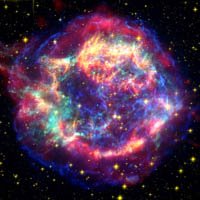Cosmological Constant & Dark Energy
 Based on an ongoing study of exploding stars in the distant universe, astrophysicists have concluded that the effect of the "dark energy" that is speeding up the expansion of the universe is within 10 percent of that of Albert Einstein's celebrated cosmological constant. Cosmologists regard this result as a major step forward in understanding the nature of this mysterious property of the universe.
Based on an ongoing study of exploding stars in the distant universe, astrophysicists have concluded that the effect of the "dark energy" that is speeding up the expansion of the universe is within 10 percent of that of Albert Einstein's celebrated cosmological constant. Cosmologists regard this result as a major step forward in understanding the nature of this mysterious property of the universe.Reporting in an upcoming issue of the journal Astronomy and Astrophysics, an international team using a variety of instruments, including the 10-meter Keck telescopes in Hawaii, show the extent to which supernovae that erupt across the universe compare to those closer to home. Measuring the receding motion of supernovae at great distances has been intensely investigated since 1998, when researchers discovered that supernovae of a given recessional velocity seem to be fainter than they would be if the expansion of the universe were slowing down. This result, which has been observed consistently for the last eight years, strongly implies that the expansion rate of the universe is increasing.
The cause of this acceleration may be some form of exotic energy that causes space to push outwards. Einstein originally proposed a mathematical fudge-factor he called the cosmological constant that would preserve the notion of a universe with no beginning and no end. But when Edwin Hubble demonstrated that the universe was expanding, Einstein abandoned the cosmological constant as his "biggest blunder." The best way to study the dark energy, whatever it is, continues to be far away supernovae. Improved observations of distant supernovae are the most immediate way in present study is a very big step forward in quantity and quality and amazingly suggests that Einstein was pretty close to the mark.
The research project is known as the Supernova Legacy Survey (SNLS), which aims to discover and examine 700 distant supernovae to map out the history of the expansion of the universe. The survey confirms earlier discoveries that the expansion of the universe proceeded more slowly in the past and is speeding up today. However, the crucial step forward is the discovery that Einstein's 1917 explanation of a constant energy term for empty space fits the new supernova data very well.
Further Reading on Related Topics: 1) SuperNova Legacy Survey, 2) Another Report on this topic, 3) Dark Energy 4) Wikipedia Article on Dark Energy 5) NASA's Site on Supernovae
Labels: Dark Energy

0 Comments:
Post a Comment